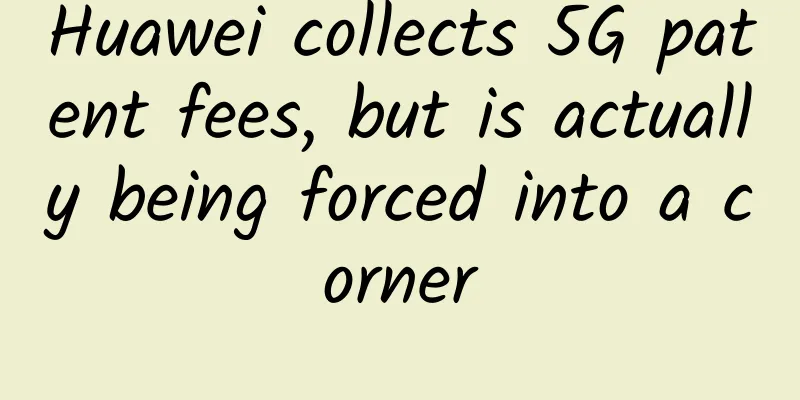Huawei collects 5G patent fees, but is actually being forced into a corner

|
Ding Jianxin, director of Huawei's Intellectual Property Department, revealed at the launch of the "Huawei Innovation and Intellectual Property White Paper 2020" at Huawei's Shenzhen headquarters on the 16th that Huawei expects its intellectual property revenue to be between US$1.2 billion and US$1.3 billion in the three years from 2019 to 2021. Huawei is willing to charge a standard essential patent licensing fee of no more than US$2.5 per mobile phone that complies with 5G standards based on the principles of fairness, reasonableness and non-discrimination.
Huawei has invested a lot of resources in 5G research and development. Now it charges 2.5 US dollars in patent fees per device according to international standards, which is understandable. In fact, this money is not much. In 2019, the sales volume of 5G mobile phones was very small, only tens of millions worldwide. According to the data of current research companies, the global sales volume of 5G mobile phones in 2020 is probably less than 300 million. Assuming that the sales volume of 5G mobile phones doubles this year, it means the sales volume is 500-600 million. Add up to about 800 million units, which means that at most, the patent fee will be more than a billion US dollars. Although the gross profit of this income seems very high, collecting this money at this point in time is actually not a good thing. Huawei is not like Qualcomm. Qualcomm relies on selling patents and components, while Huawei sells complete devices. The industrial chain of high-tech products is very long, and a product involves many patents. Few companies can hold all the patents for a certain product in their own hands. In most cases, some patents are in their own hands, and some are in the hands of other companies. When necessary, cross-licensing is done. If you encounter a company like Qualcomm that does not make the final product or makes less, you have to pay patent fees. At this juncture, it is obvious that Huawei can no longer carry out its mobile phone business normally due to the marketing ban, so naturally there is no need to exchange patents with other companies, so it can collect patent fees from others. After losing a mobile phone business worth hundreds of billions, in exchange for such a business worth tens of billions, anyone who is not stupid can see the helplessness. The so-called "counterattack" and "countermeasures" are nonsense, in fact, it is the helplessness of being forced into a corner. The business of collecting patent fees seems to have a fat gross profit, but the scale is not large. For example, everyone knows that Qualcomm is the father of Xiaomi, but looking at the financial data in 2019, Qualcomm's total revenue is not as much as Xiaomi (although the gross profit margin is much higher). Therefore, this amount of patent fees can't make up for the gap caused by Huawei's loss of its mobile phone business. It can only make a little bit of money and survive first. |
Recommend
Event operation: should we create a hit product or an event that will not attract any user complaints?
Do you worry about user complaints when you organ...
Thinking + sense of rhythm + refinement, see how excellent operations widen the gap with ordinary operations?
In this article, we will talk about the differenc...
[Longtou Taishan] "Longtou Daily Limit Code Course and VIP Information" Market Sentiment Strategy PDF Article
【Longtou Taishan】"Longtou Daily Limit Code C...
4 tips to enhance article resonance and create popular articles!
If you want an article on a public account to go ...
How to use mind mapping in product operations?
Mind mapping, as a tool, is now used in all walks...
How to create a food ordering app in Shenzhen? How much does it cost to develop a food ordering app?
The catering industry has become the first choice...
CI build performance issues caused by upgrading JDK 11 on Feishu Android
Author: Qin Bingbing & Song Zhiyang I. Summar...
Starting from March 1 next year, WeChat and Alipay personal payment codes will not be used for business payment collection. Media clarification
[[436923]] Recently, there has been news that per...
Online production of Ukrainian beauties holding signs and shouting videos, online orders, sincerely recruiting agents!
The beauty sign-holding team includes the Russian...
The latest news on the 2022 Shanghai full lifting of the lockdown: When will it be lifted? Attached is the forecast of the time of unblocking in each area
Since May, the local epidemic situation in Shangha...
Second category e-commerce advertising!
Second-class e-commerce advertising : Tencent adv...
Under the epidemic, here are three key words for brand marketing to save themselves in 2020!
Under the epidemic, no industry or brand can rema...
What are the benefits of bidding promotion? What are the advantages?
SEM promotion is to promote the products and serv...
How to improve user retention rate? Let’s talk about the big thing called “user retention”!
In the Internet industry, users who start using a...
Which website construction company is best? How to choose a website construction company?
Which website construction company is best in Don...









